I sat in Ships Lounge, just east of I-27 in Amarillo, Texas, attempting to read my book. I had just driven westward across the state with my colleague, Julie Libersat, an Associate Professor of Art, Design and Technology at Texas Woman’s University in Denton, and was looking for somewhere to stretch my legs. Our destination was Santa Fe to visit the Currents New Media Festival, which happens every June.
Ships Lounge, a local pool hall bustling with regulars vying to stake their claim in an ongoing championship league, gave signs that we had headed west: Cigarette smoke filled the room, and cash was the preferred method of payment. Bright spotlights flickered on the empty dance floor. This was a place that had not seen change in a long time.
As I flipped through the pages of my book, I wondered what aesthetic qualities I would encounter in Santa Fe. I had been only once before to the city in the mountains, when I attended the opening of SITE Santa Fe’s 2016 SITElines biennial, much wider than a line. The biennial was a survey of contemporary art organized around themes of indigenous histories and territory. Much of the art for the show was brought in from other places; Santa Fe has a population of less than 90,000, and despite the romanticism it conjures, it is a small city.
To aid understanding of Santa Fe’s cultural output, Libersat had agreed to give me a tour of its exhibitions. She has several years’ experience working the Currents New Media Festival, and knew that she could make contact with a lot of presenting artists. Although there is a lot of new media and technology in Texas in general, survey and solo exhibitions of electronic media and digital art are still rare in the state. North Texas was fortunate enough to have I’ll Be Your Mirror, a massive retrospective of over fifty years of new (and now, old) media and digital art, though its runtime was short: less than 90 days. Here, in Santa Fe, we had an extended weekend to visit with one of the longest-running convenings of these artists in the country.
There is renewed relevance in my interest in so-called new media: the Santa Fe influence has made its way to Texas. Meow Wolf’s The Real Unreal experiential installation opens in Grapevine, northwest of Dallas, on July 14. I had not yet been able to experience Meow Wolf’s original location, The House of Eternal Return, and so a visit to Currents would serve a dual purpose.
It is interesting how the zeitgeist has shifted since 2017. The House of Eternal Return is cheeky and fluorescent; the venue begs to be used as a toy rather than revered like a museum. Installation rooms vary in shape and function, and require the visitor to change the ways they interact accordingly. I now understand why the Meow Wolf hype (and criticism) is a well-mined topic. The place defies definition. It has provided more artists per square inch with exciting exhibition opportunities than any other exhibition format I can think of. It’s a venue, a playground, an experiential environment, and more. Much of the installation design seems like a child’s dream, but the storyline is decidedly ascendent of a “PG” rating.
I deliberated the question “who is this for?” quite a bit during my visit. The fast answer is: everyone. Young and old, big and small. However, the wayfinding in Return can disprivilege those with mobility concerns, or those that cannot fit in its improbable spaces; stairwells, walls and floors are sometimes incongruent with the various converging pathways, particularly in a forested area. At one junction, a short step ladder narrowly leads to a corridor which only has room for single-file, or one-way, traffic. Some would say these are the growing pains of a successful park, and it does feel that way. A family of six could all find ways to enjoy this place. In a crowd of dozens, things get a little tight.
In another room, a domed alcove of the treehouse, dotted with convex glass bulbs painted to resemble dragon eyes, I sat with Libersat. She commented that much of Meow Wolf’s design has been executed, successfully, with what are art fundamentals. I realized she is correct: the installations rely on skills that would be learned in foundational 2D and 3D design courses. There are added layers of lights, sound, and sometimes videos, but the primary material of Meow Wolf is set design. As a brand, the experience is meant to feel otherworldly, futuristic, and electrified. Although these feelings are communicated, I found the artists’ hands inseparable from the form. It’s a pretty wholesome model for an art business: the visitors will love it, but the artists will respect the creativity of the installation. I think we’ve all designed a room, at one point or other in our art careers. But this does feel different, like any creative idea could be made possible.
****
By the time we made it to the Santa Fe County Fair Grounds to visit Currents, we had already seen a lot of art. At the Thoma Foundation’s Art Vault gallery, Stan VanDerBeek’s Poem Field No. 7. (1967-68) played out its grid of colored square cells, the composition slowly mutating and changing. Lynn Hershman Leeson’s Deep Contact (1984-89) demonstrated one of the first-ever instances of interactive video, complete with a decision tree of all possible outcomes posted on a plaque near the video console. It is apparent that Santa Fe has adopted digital media as one of its halcyons.
What to expect, then, of this year’s iteration of Currents?
One evening at the festival, Libersat spoke with Currents Executive Director Frank Ragano about the process of operating the event annually. The festival brings in artists to direct the installation of their work on site, and employs interns to assist in operating the exhibitions. “Overseas shipping is really challenging,” Ragano told us. He and Libersat then reminisced about some of the festival’s greatest hits. “The couch is probably the main piece that most people remember,” he said.

Mariannah Amster, Currents’ Creative Director (left), and Frank Ragano, Currents’ Executive Director (right)
“The Couch” is Balance from Within (2012) by Jacob Tonski. It is an early Victorian sofa balancing on one leg via a “Reaction wheel,” which is a tool used in aerospace technology to reorient satellites in space. The sofa stands up, defying gravity, until balance can no longer be sustained, at which point it falls over and possibly shatters into predetermined sections. These sections are lined with magnets, which allows for the pieces to be snapped back together with ease. It is understandable why Ragano would suggest this artwork emblematizes Currents, and to a larger extent, Santa Fe. It is more kinetic (and unwieldy) than most installations at Meow Wolf, but the aesthetic qualities that the theme park espouses all present in the piece: anachronistic style and otherworldly effects, upended expectations of design, and a technologically powered “wow” factor.
Currents New Media Festival exists on a similar timeline to Meow Wolf; the first proper iteration happened in 2010. While Meow Wolf garners international praise for reinventing how art can be monetized and displayed, Currents does the work of receiving and curating contemporary new media pieces for the public. In this way, the festival is an ongoing litmus for what artists are thinking about in the realms of art and technology. It is not hard to imagine how the two entities may experience crossover in terms of artistic talent. The presence of both in the high desert of Santa Fe is strange, I admit.
The range of work on view at Currents was about as exhaustive as was in Fort Worth’s I’ll Be Your Mirror. There were kinetic sculptures, sonic sculptures, robotics, reactive software installations, video essays, images made with Generative Adversarial Networks and computational photography, textiles, games, and virtual reality. My sense is that Currents has a legacy of presenting breathtaking installations that are quite large. This year’s iteration felt more modest in size than some of the legendary festivals of years past. In this way, it seemed more dedicated to the space of the conceptual image maker. Video art was made available at various locations on the fairgrounds, including the two main exhibition buildings and an interstitial outdoor area. Wall labels featured QR codes, which pointed to the festival’s online catalog, which was particularly helpful for attendees to understand the context and technology behind the work.
Michael Zhou’s 10 (2022) appeared as an almost square window, with motorized horizontal shutters backlit with LED lights. The shutters cascaded in a variety of rhythms, before dancing to a predetermined musical composition.
Zeve Cohen and Hayden Carey’s Artifact of the Astral Valley (2022) most closely resembled the installation art that I had come to expect from Santa Fe. A fantasy-themed obelisk featured a central aperture, which opened when approached. The viewer could then use a dial on the interior console to flip through different displays, which spanned a number high-chroma textures.
Neil Mendoza’s Spambots (2022) was the most succinct, and dare I say cutest artwork on display. Two rows of “spambots” (anthropomorphized cans of literal Spam) sat in front of a computer monitor as they typed out a “piggy version” of Aldous Huxley’s Brave New World. The little bots typed one character at a time with their mechanical hands to reveal Huxley’s famous text, with many phrases reconfigured into pork-themed puns.
Nicolas Kisic Aguirre and Rawa Muñoz’s Realidad Mutada (2022) was a geodesic dome of audio speakers, with a hole on the underside and a seat directly below for the viewer. Field recordings played in the darkness of the space, eliminating the viewer’s sense of vision and enhancing their auditory perception.
In the corner of one building, I encountered Dann Disciglio’s Theses for Eco-Acoustic Avowal: Step into the Light (2022). A single spotlight was flanked by directional speakers. Upon entering the light beam, the surrounding cubicle disappeared, and the luminance from the beam reflected off of my skin, rendering the darkness aglow. I was returned to the dank environment of Ships Lounge in Amarillo, or rather, inside the memory of it.
The Currents New Media Festival ran from June 16-25, 2023 in Santa Fe. Travel accommodations for this trip were provided in part by the Texas Woman’s University Department of Visual Art. Special thanks to Julie Libersat.


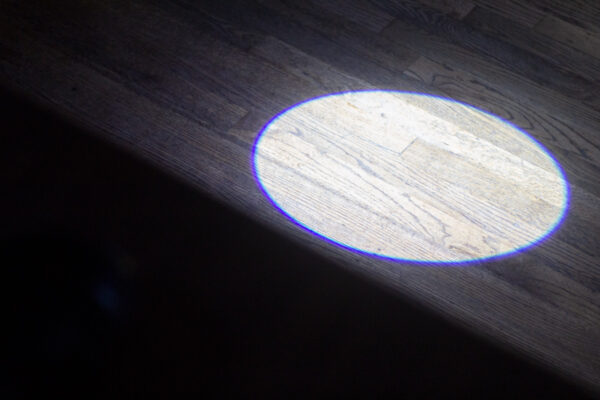
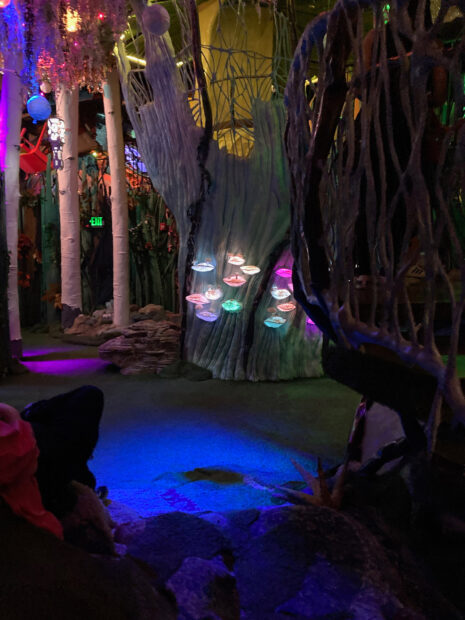
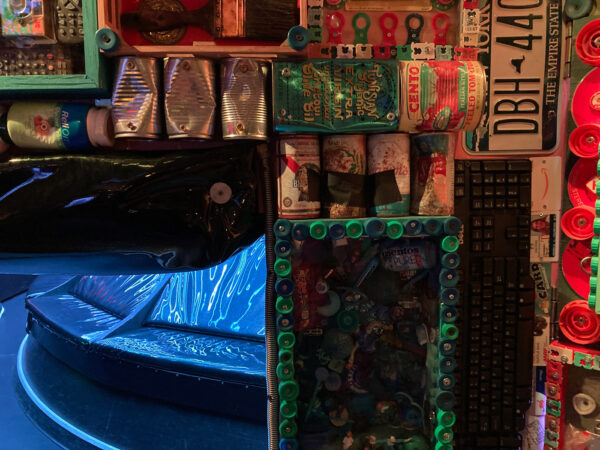
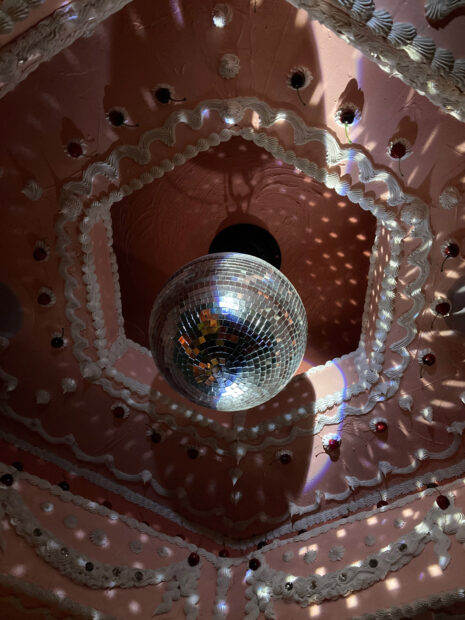
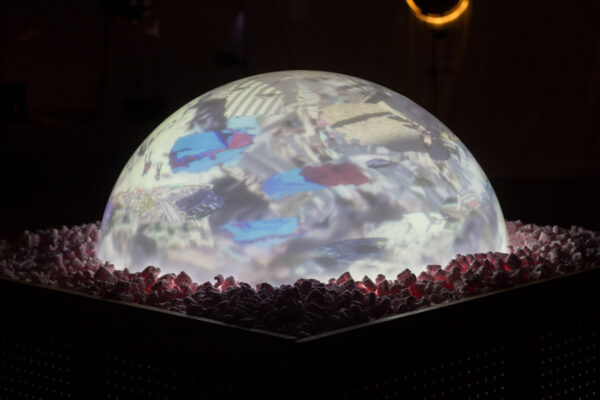
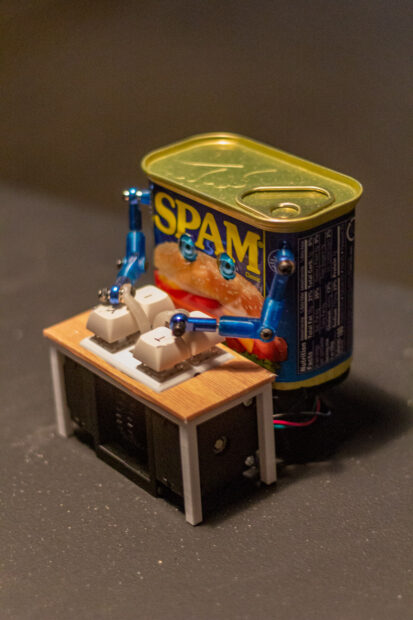
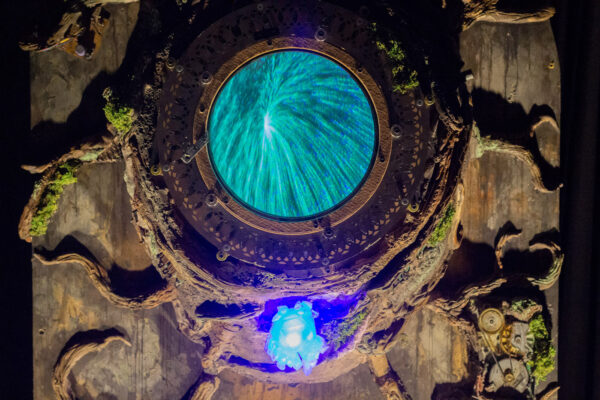
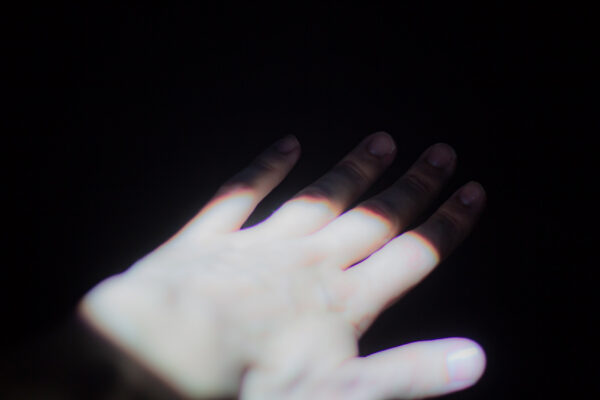

1 comment
Very well written, William Sarradet. I appreciate clear and carefully described reviews. Your writing allowed me to picture what you told us. GOOD WORK!